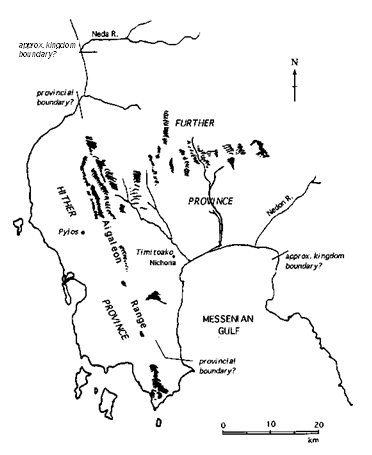Life in Mycenaean Pylos
Pylos was one of a number of kingdoms that flourished in Greece in the 14th and 13th centuries B.C. We do not know to what degree, if any, they were politically interconnected, but the inscribed tablets (Fig. 4), labels, and sealing nodules (Fig. 29) found at each center give us some information about the internal administrative structure and economic affairs of a Mycenaean kingdom. Pylos, with about one thousand tablets, has the lions share of longer and more complete texts.
Since Ventris' discovery in 1952 that the tablets were in an early form of Greek, they have added a new dimension to our understanding of Mycenaean culture. From them we know that the Late Bronze Age inhabitants of Pylos and other centers organized the production of items that do not turn up in the archaeological record, like cloth and scented oil. The Mycenaeans kept track of different breeds of oxen, collected taxes, and worshiped many of the gods we know from classical Greece, such as Zeus, Poseidon, Hera, Ares, and Dionysos. Pylos managed a large labor force, paid in figs and grain by the central administration: shepherds and weavers, perfume boilers, bronzesmiths, and bath attendants. The administrative hierarchy is also well documented, from the ruler, called by the Homeric word for king, wanaxy down to the district officials, and the menial labor force that kept the kingdom running smoothly Mycenaean social structure is less well understood.
Individuals named in the tablets are elite members of society, while lower ranking workers are mentioned only as groups. There are references to slaves also, but here a word of caution is in order. Tablets from Pylos and Knossos show that slaves could be bought and sold, but also that they could own land and large flocks of sheep and goats, and that they received rations and made contributions to the gods in quantities comparable to nonslaves. The same ambiguity applies to other modern labels like "king" and "palace": it is important to remember that the Mycenaean significance of such terms probably did not correspond exactly with ours.
These tablets are nothing like the voluminous and varied records known from the Near East. They preserve no laws, no literature, no diplomatic or private correspondence; just lists of taxes and payments, goods stored, and goods offered to the gods. Furthermore, the tablets were never intended as permanent records, and they refer to the business of a single year. They were not even intentionally baked; we possess only those that were accidentally preserved when fire destroyed the palace. Thus we have records of only the final year of any palace administration. There are month names, but only occasional references like "last year's debt" and "the bronzesmiths will pay another year." It seems clear that tablets were not kept after the current year was up; any information worth retaining longer could have been transferred to a less bulky material like leather,as we know was the Minoan practice, or to a new year's set of tablets. We do, on the other hand, know that any topic appearing in these records is sure to be palace business. 
Figure 37. Approximate area of Pylos kingdom